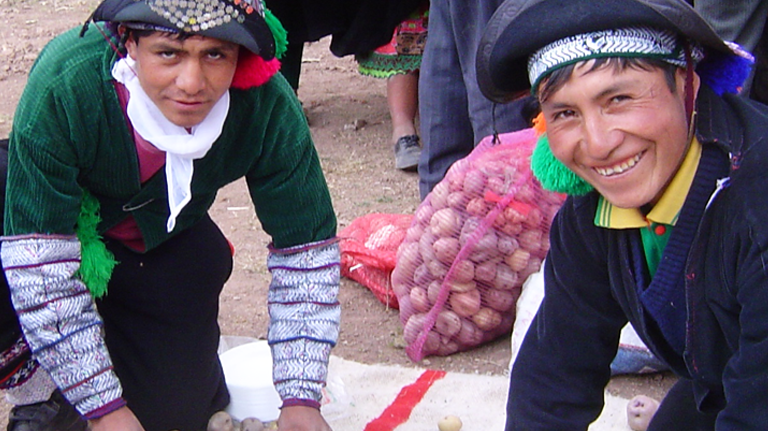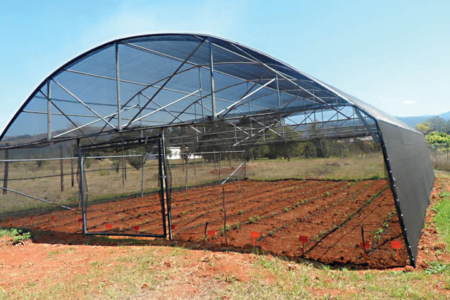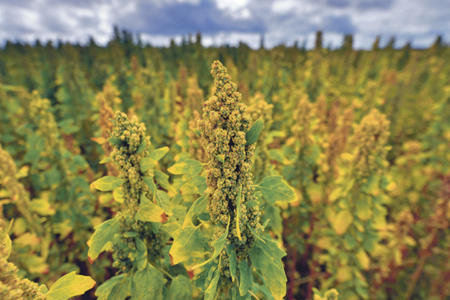
Iron and zinc deficiency are widespread problems in developing countries. Scientists at CIP have bred iron- and zinc-biofortified potatoes to contribute to efforts to reduce malnutrition in the Andes and other regions where potato is a staple crop. Bioavailability studies will determine how much iron and zinc the body absorbs from those potatoes and their potential for reducing anemia and zinc deficiency.
Background
Iron deficiency, which leads to anemia, and zinc deficiency are global problems with serious health risks. They are especially prevalent in Asia, sub-Saharan Africa and South America, where recent national surveys put the incidence of iron-deficiency anemia in non-pregnant women and children at 15% and 25% respectively in Ecuador, 40% and 36% in Peru, and 61% and 35% in Bolivia. Zinc intakes are commonly below that required for healthy child development and optimal health in adults, with zinc deficiency being widespread in the Andean highlands.
While iron and zinc supplementation and food fortification programs have proven to be effective in certain situations, their implementation requires infrastructure, significant investment and safe delivery systems. The development of crop varieties with enhanced levels of essential vitamins and micronutrients—a process called biofortification—is a timely and complementary approach with good potential to improve iron and zinc uptake in resource-poor rural and urban communities in a sustainable and cost-effective manner.
There have been significant efforts within the international community to breed biofortified varieties of staple crops, notably iron- and zinc-rich wheat, millet, potatoes and beans. While bioavailability and efficacy studies have been successfully undertaken for biofortified iron-rich beans and pearl millet, there is no evidence of the percentage of the iron in potato that people absorb (bioavailable iron).
Scientists at the International Potato Center (CIP) believe that iron and zinc biofortified potatoes are ideal for contributing to a reduction in iron and zinc deficiencies in the Andean Highlands for two major reasons. Firstly, unlike cereals and legumes, potatoes have a very low level of phytates, which inhibit micronutrient absorption, and a high concentration of vitamin C, a promoter of iron absorption—an ideal combination to maximize bioavailability. Secondly, potatoes are the major constituent of the diet of iron- and zinc-deficient Andean populations and are largely consumed without other foods. A recent estimate indicates that adults in this region consume an average of 600g of potatoes per day.

The Andean diet is remarkably low in animal products, limiting access to other potential sources of dietary iron and zinc. Thus, while strategies such as agricultural diversification also have the potential to alleviate micronutrient deficiencies, cultural and economic factors suggest that the introduction of iron- and zinc-rich potatoes could be an effective approach.
CIP has been developing iron and zinc biofortified potatoes over the past sixteen years. The first set of biofortified potatoes have iron concentrations 40–80% higher that the varieties commonly consumed in the Latin American highlands. In 2016, CIP gave 17 biofortified potato clones from this first set to the NGO Grupo Yanapai to work with smallholder farmers in central Peru’s region of Huancavelica in the evaluation and participatory selection of the clones with the best yields, appearance and taste.
The second set of biofortified potatoes is the result of crosses between individuals from the first set and an elite CIP breeding population. These clones combine elevated iron and zinc concentrations with traits such as resistance to late blight and virus diseases and tolerance to drought and heat. In 2018, 30 clones of the second set and three commercial varieties, used as controls, were planted in seven field sites scattered across Peru for participatory selection with farmers. At least 50 clones from the second set have also been sent to partners Africa and Asia as in vitro plantlets for field adaptation and evaluation there.
Objectives
- Determine the potato’s iron and zinc bioavailability in humans.
- Model the potential impact of the introduction of biofortified potatoes in alleviating iron and zinc deficiencies in the Andean highlands.
Approach
Scientists will quantify how much of the iron and zinc in potatoes is absorbed by the body. The data will then be used in models to provide estimates of the extent to which the provision of iron and zinc biofortified potatoes in the Andean highlands, and in low- and middle-income countries elsewhere, could contribute to the alleviation of iron and zinc deficiencies.
The data obtained will enable the formulation of precise breeding targets for both CIP and national potato development programs, and provide evidence required for sustained investment in the development of elite biofortified potatoes and their introduction into agriculture and food systems in sub-Saharan Africa and Asia. It will also inform nutritional scientists, dieticians and public health workers of the possible contribution of biofortified potatoes to the alleviation of iron and zinc deficiencies.
To quantify the potential impact of the introduction of biofortified potatoes, scientists will use a disability adjusted life year (DALY) modeling approach, which is an appropriate method to estimate nutritional and health impacts of biofortified crops. Furthermore, data from the proposed research, together with that from other studies, will be used to develop iron dietary intake guidelines for low- and middle-income countries.
Expected outcomes
- Percentage of iron and zinc in potato that is bioavailable (absorbed by people).
- Amount of bioavailable iron and zinc in a biofortified vs a non-biofortified locally consumed potato.
- Evidence of the potential of a biofortified potato in helping reduce iron and zinc deficiency.
- Evidence of the potential contribution of biofortified potatoes to the recommended dietary requirements of iron and zinc for two vulnerable groups: children under age 5 and women of childbearing age. Using the DALY measure, the model will estimate the potential impacts under different biofortified potato adoption (low, medium and high adoption) and consumption scenarios (e.g. rural only vs rural and urban adoption pathways).
- Extrapolation of local data to other target countries, adjusting for potato consumption levels and anemia incidence (using WHO data), to provide estimates of impact on a large scale. This analysis will offer evidence to the international community and national research programs of the potential return on investment in terms of health and nutritional benefits of potato biofortification in South America, Asia and Africa.
Contact
Gabriela Burgos
CIP-SSA
g.burgos@cgiar.org
Thanks to our donors



